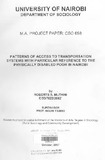| dc.description.abstract | Transport plays an important and pervasive role in allowing people to effectively participate in the economic process. It improves people's mobility, which in turn confers the opportunity of high accessibility. Mobility is fundamental in breaking isolation and thus strengthens an individual's capital base. In order to contribute to economic and social development, it has to be reliable, efficient, affordable, and demand responsive. This study was designed to understand the patterns of access to transport systems with particular reference to the disabled poor in Nairobi. A study sample of 76 was conveniently chosen by dividing Nairobi into three zones based on distance and fares paid from city center. Of the 76 study sample, 36 of them where a control group, intended to shed light on whether the disabled face the same problems as the able bodied. Out of the three zones identified, two study areas where chosen using the simple random method. As mentioned above, fifty percent of the respondents where disabled while the other half where able bodied. The study is explained by Sen's entitlement theory which asserts that famines or starvation is not as a result of lack of food but rather, the lack of enough entitlement bundles which the poor can make their own for the exchange of other goods. Similarly, this study asserts that the poor do not face transport problems due to lack of adequate public transport systems but rather due to lack of enough means to exchange for transportation. The study revealed that disabled people are more unlikely than the able bodied to receive any education and are more vulnerable to poverty. They also have least education and limited economic opportunities. They face more challenges than the able bodied in accessing transport systems including many other public services. The study also revealed that majority of the poor people in Nairobi, Kenya do not have private means of transport and walk or rely on public transport means. The public transportation modes used include the matatu and bus. Perceptions of safety/comfort are largely as a result of respondents' experiences because some of the routes studied had either the bus or the matatu while others had a mixture of the two. Findings show that transportation affects the poor but is not easy to measure the extent. This is because poverty, being multi-dimensional, has a myriad of causing and contributing factors. In order to cater for the transportation needs of the disabled, it is necessary to adopt a holistic approach; in other words, a mix of strategies is important in this respect. For example, since walking emerged as a major method of travel, it would be necessary to create footpaths that are safe for use both day and night by the provision of security and lighting. This form of strategy would reduce on the reliance on motorized transportation, and would call for services, inter alia, schools, and health and government offices to be developed within the areas that the poor reside. Similarly, since inadequate transportation systems designs were found to affect the disabled in terms of physical accessibility. would be necessary to do further research and come up with a modality of guiding such systems designs so that they are user friendly to the disabled users. Economic condition is a determinant on whether the disabled can afford to pay for public transport facilities. As such, based on Sen's entitlement theory, increasing poor people's entitlements increases their choices, among them, transportation. | en |

